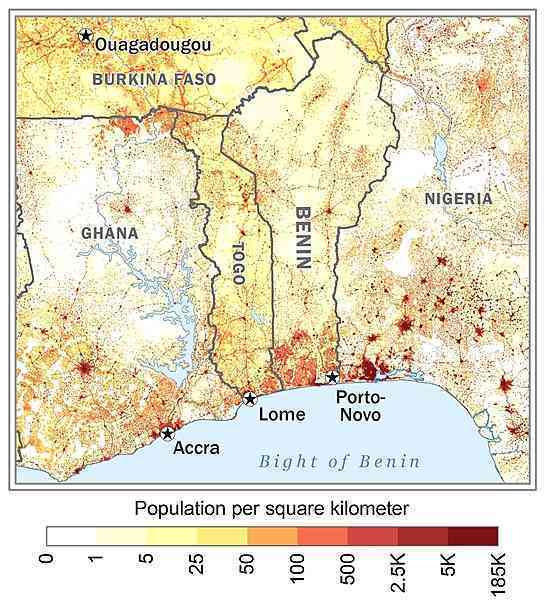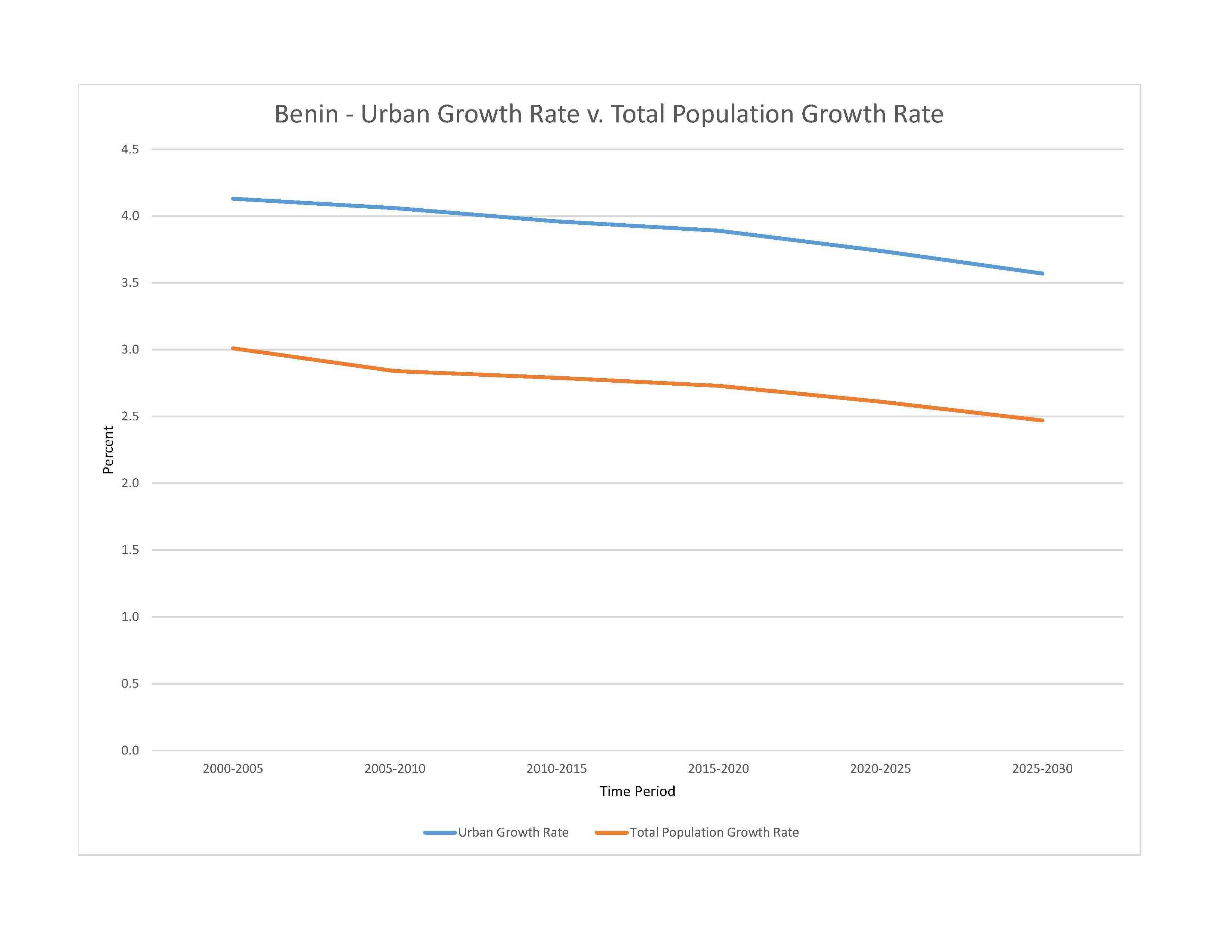
14,219,908 (2023 est.)
noun: Beninese (singular and plural)
adjective: Beninese
Fon and related 38.4%, Adja and related 15.1%, Yoruba and related 12%, Bariba and related 9.6%, Fulani and related 8.6%, Ottamari and related 6.1%, Yoa-Lokpa and related 4.3%, Dendi and related 2.9%, other 0.9%, foreigner 1.9% (2013 est.)
55 languages; French (official); Fon (a Gbe language), Yom (a Gur language) and Yoruba are the most important indigenous languages in the south; half a dozen regionally important languages in the north, including Bariba (once counted as a Gur language) and Fulfulde
Muslim 27.7%, Roman Catholic 25.5%, Protestant 13.5% (Celestial 6.7%, Methodist 3.4%, other Protestant 3.4%), Vodoun 11.6%, other Christian 9.5%, other traditional religions 2.6%, other 2.6%, none 5.8% (2013 est.)
Benin has a youthful age structure – almost 65% of the population is under the age of 25 as of 2022 – which is bolstered by high fertility and population growth rates. Benin’s total fertility has been falling over time but remains high, declining from almost 7 children per women in 1990 to 5.4 in 2022. Benin’s low contraceptive use and high unmet need for contraception contribute to the sustained high fertility rate. Although the majority of Beninese women use skilled health care personnel for antenatal care and delivery, the high rate of maternal mortality indicates the need for more access to high quality obstetric care.
Poverty, unemployment, increased living costs, and dwindling resources increasingly drive the Beninese to migrate. An estimated 4.4 million, more than 30%, of Beninese live abroad. Virtually all Beninese emigrants move to West African countries, particularly Nigeria and Cote d’Ivoire. Of the less than 1% of Beninese emigrants who settle in Europe, the vast majority live in France, Benin’s former colonial ruler.
With about 40% of the population living below the poverty line as of 2019, many desperate parents resort to sending their children to work in wealthy households as domestic servants (a common practice known as vidomegon), mines, quarries, or agriculture domestically or in Nigeria and other neighboring countries, often under brutal conditions. Unlike in other West African countries, where rural people move to the coast, farmers from Benin’s densely populated southern and northwestern regions move to the historically sparsely populated central region to pursue agriculture. Immigrants from West African countries came to Benin in increasing numbers between 1992 and 2002 because of its political stability and porous borders.
0-14 years: 45.37% (male 3,256,439/female 3,194,700)
15-64 years: 52.18% (male 3,595,897/female 3,823,786)
65 years and over: 2.45% (2023 est.) (male 159,363/female 189,723)
total dependency ratio: 84
youth dependency ratio: 78.3
elderly dependency ratio: 5.7
potential support ratio: 17.7 (2021 est.)
total: 17.1 years (2023 est.)
male: 16.6 years
female: 17.7 years
3.31% (2023 est.)
40.7 births/1,000 population (2023 est.)
7.8 deaths/1,000 population (2023 est.)
0.2 migrant(s)/1,000 population (2023 est.)
the population is primarily located in the south, with the highest concentration of people residing in and around the cities on the Atlantic coast; most of the north remains sparsely populated with higher concentrations of residents in the west as shown in this 
urban population: 50.1% of total population (2023)
rate of urbanization: 3.74% annual rate of change (2020-25 est.)

285,000 PORTO-NOVO (capital) (2018); 1.253 million Abomey-Calavi, 722,000 COTONOU (seat of government) (2022)
at birth: 1.05 male(s)/female
0-14 years: 1.02 male(s)/female
15-64 years: 0.94 male(s)/female
65 years and over: 0.84 male(s)/female
total population: 0.97 male(s)/female (2023 est.)
20.5 years (2017/18 est.)
note: data represents median age at first birth among women 25-49
523 deaths/100,000 live births (2020 est.)
total: 54.3 deaths/1,000 live births (2023 est.)
male: 59.3 deaths/1,000 live births
female: 49.1 deaths/1,000 live births
total population: 62.6 years (2023 est.)
male: 60.8 years
female: 64.6 years
5.39 children born/woman (2023 est.)
2.63 (2023 est.)
15.5% (2017/18)
improved: urban: 79% of population
rural: 70.8% of population
total: 74.7% of population
unimproved: urban: 21% of population
rural: 29.2% of population
total: 25.3% of population (2020 est.)
2.6% of GDP (2020)
0.07 physicians/1,000 population (2019)
0.5 beds/1,000 population
improved: urban: 56.3% of population
rural: 18.1% of population
total: 36.6% of population
unimproved: urban: 43.7% of population
rural: 81.9% of population
total: 63.4% of population (2020 est.)
degree of risk: very high (2023)
food or waterborne diseases: bacterial and protozoal diarrhea, hepatitis A, and typhoid fever
vectorborne diseases: dengue fever, malaria, sexually transmitted diseases: hepatitis B (2024)
animal contact diseases: rabies
respiratory diseases: meningococcal meningitis
note: on 31 August 2023, the US Centers for Disease Control and Prevention (CDC) issued a Travel Alert for polio in Africa; Benin is currently considered a high risk to travelers for circulating vaccine-derived polioviruses (cVDPV); vaccine-derived poliovirus (VDPV) is a strain of the weakened poliovirus that was initially included in oral polio vaccine (OPV) and that has changed over time and behaves more like the wild or naturally occurring virus; this means it can be spread more easily to people who are unvaccinated against polio and who come in contact with the stool or respiratory secretions, such as from a sneeze, of an “infected” person who received oral polio vaccine; the CDC recommends that before any international travel, anyone unvaccinated, incompletely vaccinated, or with an unknown polio vaccination status should complete the routine polio vaccine series; before travel to any high-risk destination, the CDC recommends that adults who previously completed the full, routine polio vaccine series receive a single, lifetime booster dose of polio vaccine
9.6% (2016)
total: 1.25 liters of pure alcohol (2019 est.)
beer: 0.81 liters of pure alcohol (2019 est.)
wine: 0.02 liters of pure alcohol (2019 est.)
spirits: 0.2 liters of pure alcohol (2019 est.)
other alcohols: 0.22 liters of pure alcohol (2019 est.)
total: 6.9% (2020 est.)
male: 11.8% (2020 est.)
female: 1.9% (2020 est.)
16.8% (2017/18)
68.3% (2023 est.)
women married by age 15: 9.4%
women married by age 18: 30.6%
men married by age 18: 4.8% (2018 est.)
3% of GDP (2020 est.)
definition: age 15 and over can read and write
total population: 45.8%
male: 56.9%
female: 35% (2021)
total: 11 years
male: 12 years
female: 10 years (2020)
NOTE: The information regarding Benin on this page is re-published from the 2024 World Fact Book of the United States Central Intelligence Agency and other sources. No claims are made regarding the accuracy of Benin 2024 information contained here. All suggestions for corrections of any errors about Benin 2024 should be addressed to the CIA or the source cited on each page.
This page was last modified 04 May 24, Copyright © 2024 ITA all rights reserved.